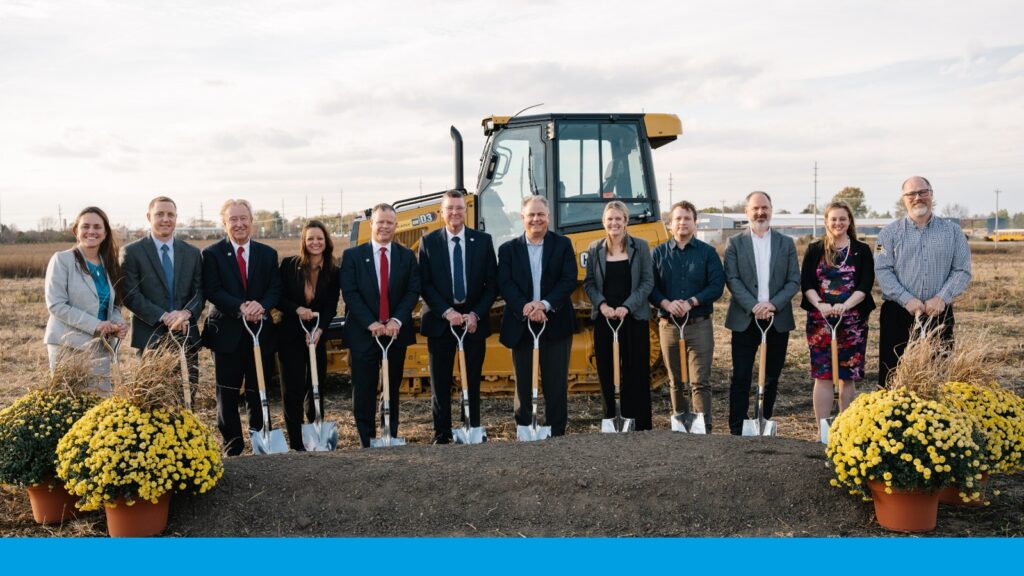By Aspire Economic Development + Chamber Alliance
Local economies change and evolve at the pace of their real estate sectors. Industry experts have shared their perspectives on the anticipated trends and challenges for commercial and residential development in 2024.
Senior Broker at Bradley Company, Sam Karozos, provided a glimpse into the future of the multifamily residential market.
“We are seeing/have seen a slowdown in new construction starts that will continue into first half of 2024, paired with a slight and temporary pullback in psf (per square foot) rents,” he said.
However, Karozos still expresses an optimistic view. He foresees lower rents through Q1 and Q2, with a reversal in fed policy and decreased interest rates, making Q3 and Q4 even more promising for new development.
“I am bullish on the outlook for Q3 and Q4 2024. Apartments will continue to be in high demand,” Karozos added.
Highlighting key factors influencing the market, Karozos mentioned the cost of capital, high input costs, limited post-2020 rental data, and the impact of interest rates.
“High interest rates negatively impact investment sales, as rates creep higher to compete with bond and CD (certificates of deposit) rates,” said Karozos. “High interest rates are also the primary factor in preventing new homeownership, with most Americans unable to afford the monthly payment for a median-priced home, which is also increasing demand for apartments.”
To offer a more comprehensive view, Karozos deferred to some of his business partners who have insight into more specialized areas of the market.
Michael Horrigan, Senior VP & Director of Land Services at Bradley Company, echoes a positive finish in 2023 and strong headwinds in 2024 for the multifamily market amid a national housing shortage.
“Nationally, we are still 5-6 million units short on housing whether that be multifamily or single family and I do not see that going away soon,” said Horrigan.
“The cost of capital and other input costs are the biggest challenge for developers and wages not keeping up with inflation. This is a huge challenge for both renters and owners. The Wall Street Journal showed the other day that it is about $1,000 cheaper per month to rent than own at present.”
Gabrielle Rubenstein, land acquisition manager at Buckingham Companies, noted the overall housing supply shortage, anticipating a steady absorption of recently delivered units, particularly in Johnson County, fueled by its desirability and strong rental demand.
“We’re continuing to move on deals that make financial sense and are looking forward to starting several new construction projects in 2024,” said Rubenstein. “I expect 2023 to finish out without many more new multifamily construction starts.”
“I would expect Johnson County to still have multifamily construction starts and a steady pace of absorption due to it being a highly desirable submarket to live in Indiana,” Rubenstein added.
“Its strength in schools, amenities, parks and proximity to employers, coupled with increasing for sale home prices, will continue to fuel rental demand. The multifamily projects that have recently delivered in Johnson County have seen great absorption, which is a testament to the demand and desirability of the area,” she said.
Addressing market challenges, Rubenstein acknowledged the impact of higher interest rates and construction costs on project viability.
“There is still an overall housing supply shortage in the country so the demand for units is present, but I expect less multifamily construction starts in 2024 due to the challenging macroeconomic conditions,” Rubenstein said.

Rubenstein sees the challenges in the market as not specific to Johnson County but more to the overall macroeconomic climate. With higher interest rates and construction costs that have not come down to pre-pandemic pricing, projects have a harder time getting financed.
“Banks have much larger portfolios of commercial real estate loans, so they are much more selective in what real estate projects they will underwrite,” said Rubenstein. “Banks want to see high-quality projects in great locations with a strong developer. Across the board, it is taking more creativity and sharpening of pencils to get projects to the finish line.”
Challenges aside, Rubenstein said that the multifamily market in general sits in a good spot due to the overall housing shortage.
“As it relates to the Johnson County market, it has a vast number of strengths as it is such a desirable place to live. The school systems rank top in the state, there are quality jobs in the county and easy proximity to jobs in Indianapolis, great community amenities and parks, and low crime. Ultimately, these factors will continue to drive a strong rental housing market.”
Turning from the financial perspective to zoning and site selection, Ross Reller, senior VP at Bradley Company, stressed the significance of a diversified economy. Reller started his central Indiana career in commercial real estate in 1982.
Reller’s concern with the market is that while the multifamily market is likely to grow, the shortage of other housing options as well as hindered commercial and industrial development illustrates the need for lower interest rates.
“Our land brokerage team assists developers with site selection throughout Central Indiana and in all zoning and use categories. It is not a healthy sign that the most active area for site selection is the multifamily use category,” said Reller.
“A diversified economy requires vitality in all use categories: office, manufacturing, retail, single family homeownership and multifamily,” he said. “Local and state leaders need to send a strong message to Washington that interest rates must come down in order to promote vitality and health in the other use categories.”
Shifting the focus fully to the commercial real estate market, Jacque Haynes, senior broker at Midland Atlantic Properties, provided insights into 2023 and beyond. Specializing in retail properties, Haynes has over 30+ years of experience in leasing, development, asset management and tenant site selection.
As downtown Indianapolis’ office market makes its recovery, suburban markets, particularly in Johnson County, have remained strong.
“Endress Hauser broke ground for their 106,000-square-foot new manufacturing and office building which will make a great impact in Greenwood and add high earning jobs,” said Haynes.
“Vacancy in the Greenwood market for retail properties is below 5% and given the demand for retail space, it is spurring new development. Retail shops were built and fully leased in Franklin on U.S. 31 and more development is planned just north of the Franklin Meijer. Market District Grocery is under construction with a new store at Smith Valley and Morgantown in Greenwood and will include 15,000 square feet of retail shops.”
Given the continued expansion of residential units, Haynes said that State Road 135 is poised for growth with new developments planned between Stones Crossing and State Road 144.
“Bargersville is attracting retailers and restaurants who are attracted by the cool street vibe and reinvestment into the downtown area,” she said.
Haynes anticipates the commercial real estate market to stay healthy in 2024, fueled by continued residential growth. She identifies interest rates, consumer spending and the completion of I-69 as factors influencing the market’s strengths and challenges.
“The continued residential growth in Johnson County is fueling demand for retail and commercial services. Although there may be a slight slowdown in some sectors, commercial real estate will continue to remain healthy,” said Haynes.
“Obviously, interest rates have impact both on new construction and existing properties who may be faced with refinancing. However, consumer spending is projected to remain steady, which keeps retail and service-oriented businesses stable. The residential growth in Johnson County, and the completion of I 69, will create opportunities for more development into 2024.”

May I have information on the topic of your article?
Hello, Maria: You may go Aspire’s website at https://www.aspirejohnsoncounty.com/